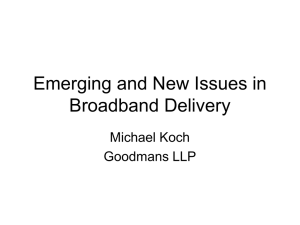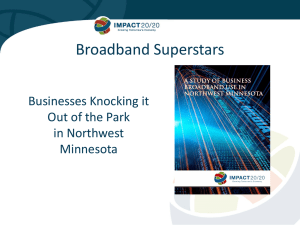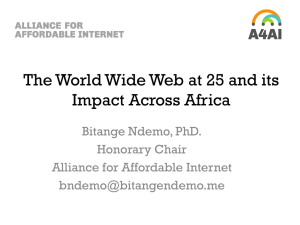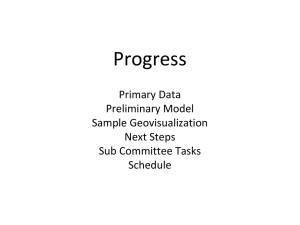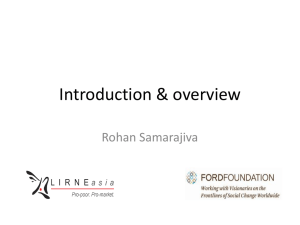1-Digicel_Presentati..
advertisement
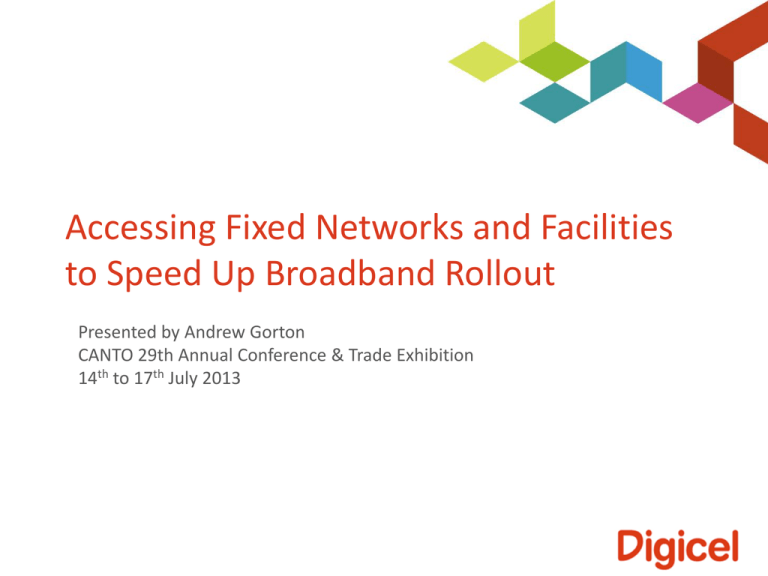
Accessing Fixed Networks and Facilities to Speed Up Broadband Rollout Presented by Andrew Gorton CANTO 29th Annual Conference & Trade Exhibition 14th to 17th July 2013 Summary In the context of broadband delivery and fixed networks and facilities I will look at: 1. The general basis of the requirement for access to fixed networks and facilities for broadband delivery; 2. Cost effectiveness and customer demands; 3. The reasons that operators require the option of fixed transport as a part of their overall strategy to compete fully for broadband; 4. The reasons that nationwide fixed infrastructure is not economically replicable; 5. How access to fixed networks and facilities in the Caribbean where an operator has dominance in local loop provision, access to non telecoms facilities, and building codes can accelerate broadband penetration. 1/ Requirement for Access to Fixed Networks/Facilities for Broadband Delivery a) The need to deliver huge amounts of data, and in particular video data, for broadband purposes requires operators to use the most cost effective means of delivery. b) Lower costs lead to lower retail prices which will do the most to drive broadband usage and penetration. c) Long established and depreciated fixed networks and facilities (including non telecoms facilities) an represent and facilitate the lowest cost mechanisms for data transport. d) Some customers also insist on fixed underground network delivery of their critical data. 1/ Requirement for Access to Fixed Networks/Facilities for Broadband Delivery Global Internet Protocol Traffic (PB per Month) - Cisco Visual Networking Index 2013 2012 2013 2014 2015 2016 2017 CAGR Fixed Internet 31,339 39,295 47,987 57,609 68,878 81,888 21% Managed IP 11,346 14,679 18,107 21,523 24,740 27,668 20% Mobile Data 885 1,578 2,798 4,704 7,437 11,157 66% Note that: a/ public internet traffic is a subset of about 60 to 70% of total IP traffic; b/ over 50% of public internet traffic is forecast to originate from wireless devices (including mobile) by 2017. 2/ Cost Effective Delivery of Broadband and Customer Demands a) Established fixed networks and supporting infrastructures are generally heavily depreciated. In other words, the cost of laying the network and in particular the cost of digging trenches and laying ducts and building other infrastructure was long since recovered. b) Costs are therefore generally limited to ongoing operational and maintenance costs. c) Fibre can be laid down the existing fixed infrastructure to provide the highest possible capacity; high speed copper technologies are also possible. 2/ Cost Effective Delivery of Broadband and Customer Demands d) A depreciated fixed network and supporting infrastructure will represent the lowest cost and highest capacity way of delivering broadband in some cases. e) In those circumstances there is a need to transport as much data as far as possible via a fixed network to keep costs and prices to customers down. 3/ Reasons Broadband Operators Require Fixed Transport Options In order to: i. ii. iii. meet increasing demands for Broadband data; offer Broadband data at the lowest cost (which is the key determinant in driving customer take up); Meet customer requirements where they require fixed underground delivery of data. There is a need for service providers to utilise fixed networks as a part of their overall broadband delivery strategy if they wish to be able to compete effectively across the entire telecommunications market and to drive broadband penetration. 4/ Nationwide Fixed Network Support Infrastructure Not Viable to Replicate 1. The cost of replicating the entire national supporting infrastructure along which an incumbent’s fixed underground network is laid is, generally speaking, not likely to be viable. 2. The costs of civil works including trenching and ducting, as well as the challenges of planning restrictions represent too great a barrier. 3. The European Commission’s June 2012 report on its 2011 Telecommunication Market and Regulatory Developments investigation which states that: “….it is estimated that up to 80% of the costs of next generation network (NGN) deployment are related to civil works…” 5/ Access to Caribbean Fixed Networks and Facilities Where Dominance Exists a) Access to the fixed networks and facilities of operators which have dominance in local loop provision (fixed network subscriber lines) will enhance broadband competition, lower prices and thereby to accelerate take up by citizens. b) There are a variety of approaches in this regard including duct access; local loop unbundling (copper and fibre); bitstream, and white-label services as implemented in many countries worldwide. European experience has shown that LLU is the best long term proposition. “New entrants use local loop unbundling (fully unbundled lines and shared access) as the main option to access the incumbent network. There is a continuous migration towards full LLU, all other types of access to the incumbent network is going down.” (Circa 35 million unbundled local loops and increasing, closest other is bitstream at circa 5 million) - European Commission’s Digital Agenda Scoreboard 2013 5/ Access to Caribbean Fixed Networks and Facilities where Dominance Exists d) We therefore encourage incumbents, regulators and Ministries as applicable to start the work with other operators of establishing the detailed terms and conditions for access to fixed networks and facilities owned by players with market dominance, as well as non telecoms infrastructure, as those will take some time to complete. e) In particular pricing will be a very important feature as incumbent fixed network pricing in the region for example overall seems to have received relatively little attention, probably because mobile has received so much attention. f) For example, the average cost of fixed interconnection in Digicel’s markets is 416% of the average cost found in Europe (circa 2.7 US cents versus 0.6 US cents). 5/ Access to Caribbean Fixed Networks and Facilities Where Dominance Exists g) Building codes could require telecoms ducting to be installed when civil works eg roads, or houses are being built, or at least provide the opportunity to let providers install ducts. h) Long standing duct, pole and copper access should be at cost. i) Fibre access pricing can perhaps be given more latitude. Recap I have looked at: 1. 2. 3. 4. 5. The general basis of the demand for access to fixed networks and facilities for broadband delivery; The reasons that access to fixed networks and facilities can sometimes be the most cost effective approach; The reasons fixed delivery is a necessary part of the overall strategy to compete fully in broadband provision; The reasons that nationwide fixed infrastructure is not economically replicable; How access to fixed networks and facilities in the Caribbean where an operator has dominance in local loop provision, as well as access to other infrastructure, and building codes can accelerate broadband penetration. Thank You !

